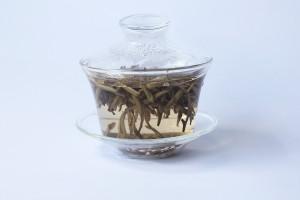White tea is probably the category of tea with the smallest range of varieties. Most publications commonly describe it as 3 varieties- Silver Needles, White Peony and Shou Mei/ Gong Mei (Longevity or Tribute Brow). In recent years, new varieties have sprouted up with productions in Fujian slowly gaining popularity.

What is White Tea?
As outlined in this article, teas are categorized according to its method of production. Unlike most other categories, white teas are more characterized by what it DOESN’T go through. It does not go through rolling or ‘shaqing’ (heating to destroy the enzymes that cause oxidation), hence its leaves are slightly oxidized and in the case of White Peony, it can look quite varied.
Typically- white teas are withered and dried- for Zhenghe style, it’s sun-dried while for Fuding style it’s baked lightly at 40-50°C.
Comparison of the 3 Types of White Tea

As seen from the photo, the Silver Needles made from buds. In fact, part of the production of Silver Needles includes a step called ‘extraction of needles’ where partially grown leaves are pared from the buds. As for what they do with the pared leaves, we will take a look at it later.
In terms of picking requirements, Silver Needles in Fujian are made from buds picked in Spring alone because of its quality and higher nutritional value. White Peony is harvested 3 times a year with 1 bud to 2 leaves ratio while Shou Mei is harvested 3 times a year with whatever is left over. In addition, pared leaves from Silver Needles may also be used in production of Shou Mei.

One thing of note for white teas is that they are covered with downy fur, a characteristic of younger leaves grown from the Dabaicha cultivar. The fur is quite obvious for both the Silver Needles and White Peony leaves where the range is greater for the Shou Mei.
From the liquor, you can see that Silver Needles because of its delicate buds tend to have liquor that is lighter in color followed by White Peony and finally Shou Mei.

From the wet leaves you can see that the Silver Needle is a sturdy, well-nourished bud, equal to size to the 2 leaves of a Shou Mei. The White Peony is made from more matured leaves and it’s obvious from the size.
Brewing Methods
The recommended brewing methods for white tea can really vary, some advocate boiling water because the higher heat is needed to unleash the taste of the unrolled leaves while others advocate lower water temperatures because of the delicate leaves.

